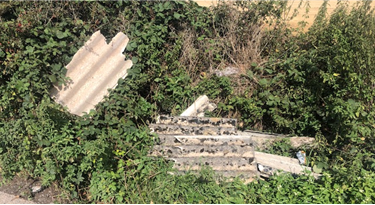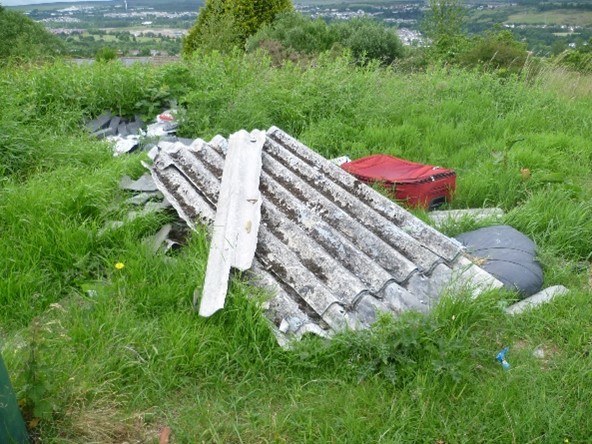
Fly tipping, Asbestos and You
What is Fly Tipping?
Fly tipping is a criminal offence under Section 33 of the Environmental Protection Act 1990 defined as:
“a person shall not… deposit controlled waste, or knowingly cause or knowingly permit controlled waste to be deposited in or on any land unless a waste management licence authorising the deposit is in force and the deposit is in accordance with the licence.”[1]
Fly tipping is the only crime where the victims (i.e. the landowners) have a legal responsibility to dispose of the waste at their own expense, and they can be fined if they do not remove it. Fines can be up to £5000 and a further £500 per day.
It is estimated[2] that in the UK, the cost of fly tipping to private landowners is up to £150m a year, compared to cost to Local Authorities of c£50m p.a.
If the fly tipper is caught, the maximum penalty is a £50,000 fine and/or 5 years imprisonment.
In the year 2021/22 in Herefordshire there were 6 prosecutions brought, which resulted in fines totalling £12,466 and 1 prison term. This is out of 806 incidents that were recorded by
the Council, 148 of which were on private, commercial or agricultural land. It does not include those where landowners did not inform the council.
From the figures available on the DEFRA website[3] for 2021/22 covering the whole of the UK, in Herefordshire, there were 4 recorded instances of illegal fly tipping of asbestos, out of 3022 in England. How many incidents were left unreported?
Health risks from exposure to asbestos arise not from its presence but in the number of fibres that are inhaled when airborne. The more damaged the ACMs are, and the type of asbestos, either bonded or fibrous, increase the risks to you and those who come across it.
What do you need to do if (you suspect) Asbestos Containing Materials have been illegally dumped on your land?
If you are unsure, have one or more samples tested. This can be arranged through Asbestos Surveyors, or many Licensed Asbestos Removal Companies (LARCs) can organise this for you.
Firstly, restrict access to the area where fly tipping has taken place. Use Tape and Notices to warn others. If the amount of waste is large, cover it with 1000-gauge polythene sheeting, and peg it down with tent pegs. Attach Asbestos warning stickers and mark out an exclusion zone with warning tape.
The HSE provides guidance on the safe removal of Asbestos Containing Materials (ACMs) in its Asbestos Essentials suite of information[4] but do note that ‘a38 – How to deal with fly-tipped asbestos waste’, they state “If the waste is spread around or mixed with non-asbestos material, get an HSE-licensed contractor to deal with it.” You will also need both the correct personal protective equipment and respiratory protective equipment.
LARCs will be able to ensure that all the ACMs are removed safely and efficiently, meaning that you, your employees and/or your neighbours, and their own staff, are protected from the risks arising from exposure to asbestos, and have the right equipment, skills, knowledge, experience and training.

How Hereford Asbestos Services can help
At Hereford Asbestos Services, we have recently (as of March, 2023) had our licence from the HSE renewed for a further three years, and also are legally able to transport and dispose of the waste because we are an Upper Tier Waste Carrier and Dealer registered with the Environment Agency.
You can contact us by
Telephone: 01432 270113, or
Email us at info@herefordasbestos.co.uk
Where we will be more than happy to help.
[1] https://www.legislation.gov.uk/ukpga/1990/43/section/33
[2] https://www.vpsgroup.com/news/fly-tipping-reaches-one-million-cases-a-year
[3] https://www.gov.uk/government/statistical-data-sets/env24-fly-tipping-incidents-and-actions-taken-in-england
[4] https://www.hse.gov.uk/asbestos/essentials/
Get in Touch
Units 2-3 Pearson Business Park, Coldnose Road, Hereford HR2 6JL
01432 270113
info@herefordasbestos.co.uk
